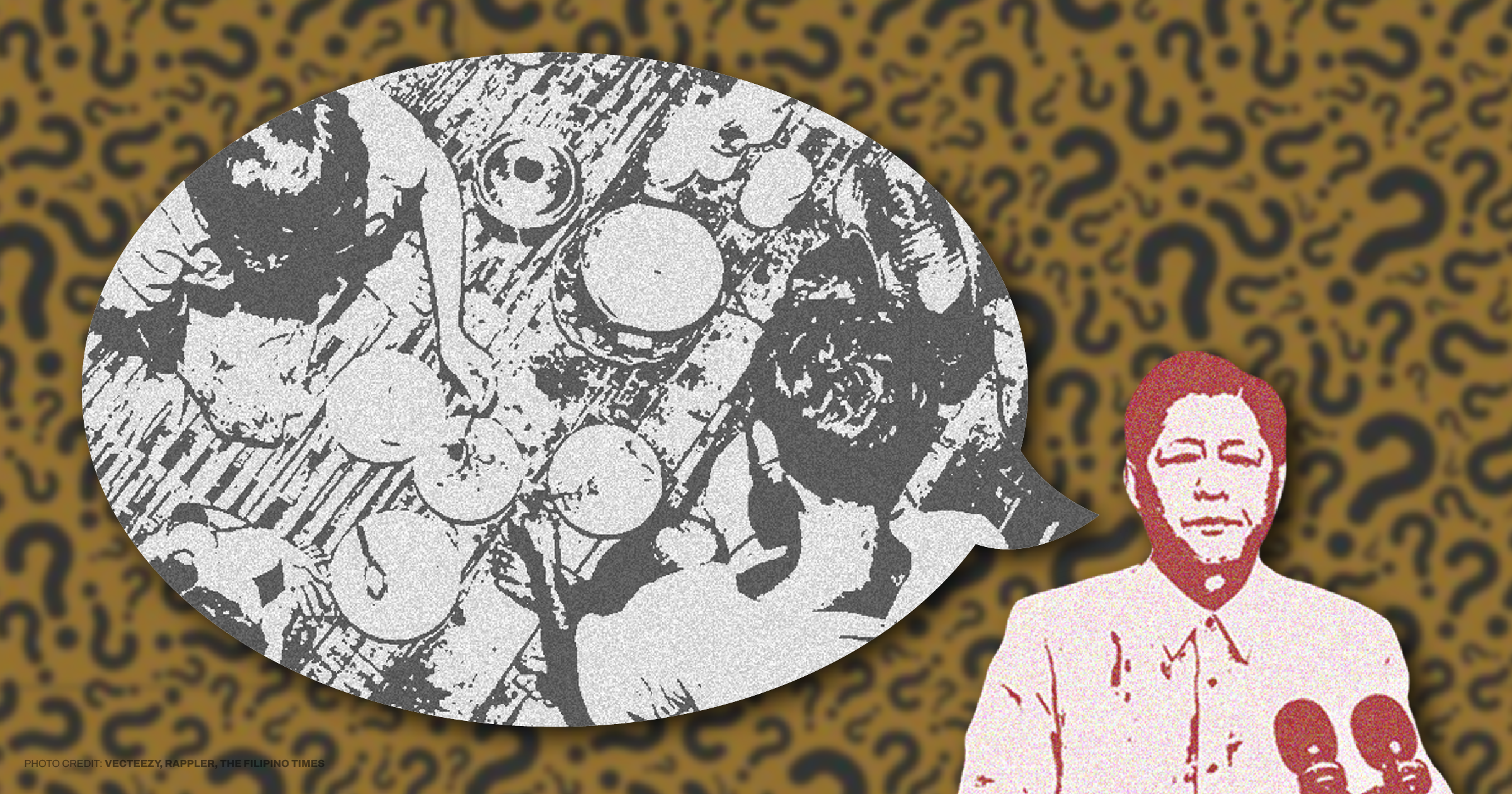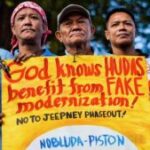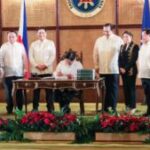We’ve seen social media posts where someone pretends to complain about being tired from traveling with a carefully composed picture subtly hinting at their business class experience – but not too subtly. Pres. Marcos Jr opened the 2024 state of the nation address (SONA) with his own bit of humble-bragging.
The very first thing he said was exactly what his administration has been repeating since last year in the country and abroad – that the Philippines is “among the best-performing in Asia.” There was a seeming show of sensitivity with an acknowledgement that it “means nothing to [Filipinos]” suffering high prices especially of rice.
But the show of modesty or self-deprecation didn’t last long. Instead of taking accountability for the high prices causing millions of Filipinos significant distress, he immediately blamed the domestic market, the global market, war, supply chains and nature. This set the stage for most of the SONA – a mechanical cherry-picked listing of this effort or the other to give the impression that the government is doing everything it can for ordinary Filipinos.
There was a final piece of economic braggadocio towards the end of the SONA – reporting that millions of Filipinos have been lifted from poverty and that the poverty incidence has “significantly” dropped. This confirmed that the moment of sensitivity to the plight of distressed folks at the start of the SONA was fleeting. The president was essentially saying that however Filipinos might feel, there are less poor under his watch.
Reported poverty
Reducing poverty would certainly be an accomplishment to be proud of. The question is – are there really less poor Filipinos as Pres. Marcos Jr claimed?
There is no reason to doubt the Philippine Statistics Authority’s (PSA) data-gathering through its now biennial Family Income and Expenditure Survey (FIES). The 2023 FIES shows that Filipinos reported as poor fell from 18.1% of the population in 2021 to 15.5% or 17.5 million in 2023, which is where the 2.5 million lifted from poverty reported by the president at the SONA comes from.
However, the most that this really says is that the number of Filipinos officially reported as poor has fallen – which is unfortunately not the same as saying that there are now less poor Filipinos. All the PSA data shows is that the income of the very poorest Filipino families increased enough to bump them above the unrealistically low official poverty line.
Looking at the situation between 2021 and 2023 can also be misleading because this includes the time of the economy reopening after the over-long lockdowns of the previous Duterte administration. The uptick in economic activity in this period was mostly from an economy restarting than from any real fundamental progress.
Understated poverty
The official poverty threshold, or the income level below which one is considered poor, is set at a national average of Php91 per person per day. This is self-evidently too low to provide for a person’s basic needs – for food, housing, utilities, transport, communication, education, health, and clothing in the modern era. Computed for a family of five, this comes to Php13,873 monthly.
There are other data showing the insufficiency of the official standard for poverty. For instance, the private outfit Social Weather Stations (SWS) has collected poverty data much more frequently than the government with its now quarterly self-rated poverty surveys that started as biannual surveys in 1986.
The annual average of SWS’ self-rated poverty shows constancy with 48% in 2018, 46% in 2021 and 48% in 2023. Looking at both self-rated poor and borderline rates for a broader measure of poverty and vulnerability is even more disturbing – 76% in 2018, 80% in 2021 and 79% in 2023. SWS reports a median self-rated poverty threshold from their respondents of Php15,000 monthly.
The Bangko Sentral ng Pilipinas’ (BSP) quarterly Consumer Expectations Survey (CES) conducted since 2004 has a corroborating result. The reported percentage of Filipino households without savings is persistently high and has even risen from an annual average of 65% in 2018 to 72% in 2021 and 69% in 2023.
In terms of magnitudes, according to SWS, the number of self-rated poor grew from 11.2 million in 2018 to 13.2 million in 2023, and of self-rated poor and borderline from 17.7 million to 21.6 million over the same period. According to the BSP, the number of households without savings grew from 16.1 million in 2018 to 18.4 million in 2023.
To be clear, these data do not contradict the official poverty reported by the PSA because they measure different things. The PSA’s 2023 FIES results report that the income of 2.5 million among the very poorest increased by enough to bring them over the official poverty threshold and to no longer be reported as poor. The SWS and BSP results, on the other hand, paint a broader picture of much more widespread poverty according to self-rating and household savings metrics.
The lived experience of most Filipinos will likely affirm that the latter metrics are closer to the truth of Philippine poverty – i.e., where around seven- to eight-out-of-ten Filipino families (or some 18-22 million families) must be considered poor or vulnerable.
Artificial improvements
Which raises the question of what increased the income among the very poorest of Filipinos by enough to bump them over the official income-based poverty threshold. There is reason to conclude that this is mostly from vastly increased ayuda, or ad hoc government social assistance (especially cash assistance), rather than from improving job opportunities.
The distinction matters because higher family incomes from bread-winners engaging in more productive and higher-earning economic activity genuinely shows an economy doing better. On the other hand, higher family incomes from more or larger government social assistance programs is basically artificial progress.
Emergency assistance for Filipinos in need is completely justifiable and a core responsibility of government. However, after a point, institutionalized and expanding ayuda programs stop becoming a sign of socially responsible governance but of chronic development failure (and even of hyper-patronage politics). The Philippines has reached that point.
Official poverty incidence was reported as falling from 16.7% in 2018 to 15.5% in 2023, or an incremental 130,000 reduction in so-called poor Filipinos to 17.5 million. This cannot have come from hyped improved labor market conditions as a more refined interpretation of PSA Labor Force Survey (LFS) figures would show.
The term “employment” presumably means working for some kind of remuneration. However, PSA employment data includes the odd category of “unpaid family workers” as among those considered employed. This increased greatly from 2.3 million in 2018 to 3.9 million in 2023 to bloat officially reported “employment” figures. Taking them away from the official employment count would show an employment rate falling from 89.4% of the labor force in 2018 to 88% in 2023.
By the same token, adding them to the official unemployment count would show an increase in the unemployment rate from 10.6% in 2018 to 12% in 2023. This estimation does not yet even include the millions of discouraged jobless Filipinos unfortunately not counted by official statistics as unemployed and instead categorized as “not in the labor force”.
Amid a deteriorating jobs situation that stifles job-seeking efforts, millions of Filipino families are becoming more and more reliant on ayuda to get by. By IBON’s initial estimation, the budget for the government’s ayuda programs doubled from around Php140 billion in 2018 to Php279 billion in 2023 – consisting mostly of the Pantawid Pamilyang Pilipino Program (4Ps), services for individuals and families in difficult circumstances, Tulong Panghanapbuhay para sa Ating Disadvantaged/Displaced Workers (TUPAD), social pension, and indigent medical assistance programs.
These programs mainly target the poorest families at the lowest income deciles including many at just below the official poverty threshold. The ayuda programs are large enough to potentially give families in the lowest income groups anywhere from Php20,000-40,000 in additional income annually, depending on the extent of their access to the different social programs.
The slight increase in family incomes from Php279 billion worth of social assistance programs is most of all what bumped the 130,000 Filipinos above the low official poverty threshold and caused the extremely incremental 1.2 percentage point decrease in poverty between 2018 and 2023.
Will the government be able to achieve single-digit poverty incidence by the end of its term? This will not happen from any real improvements in the jobs situation where employment and earnings are stifled by low wages and worsening informality due to relentless agricultural and Filipino industrial decline. The Marcos Jr administration seems unable to even conceive of real social and economic reforms to fix this.
On the other hand, the government’s capacity to give targeted social assistance and protection is certainly developing quickly especially after the marked expansion in programs since the pandemic. The electoral contest for the presidency in 2028 is also a strong motivation for the incumbent administration to spike ayuda even only momentarily. The over-riding concern for so-called fiscal consolidation and fear of how financial markets will respond will temper this impulse though.
Despite much put-on enthusiasm today, there are strong reasons to doubt single-digit poverty incidence will be achieved by the end of the Marcos Jr administration.
Really eradicating poverty
Poverty is high and chronic because of persistent joblessness. Joblessness is stubborn because obsolete neoliberal policymaking is just worsening the economy’s deep structural defects. Economic activity is predominantly low-productivity and poor at job-creation, with weak interlinkages and no real dynamism.
Policymaking and economic structures are biased to enriching the rich and leaving the poor and middle class behind. The double life of the Philippine economy of poverty for the majority and extreme wealth and profits for a few is not accidental.
Better-looking poverty statistics shouldn’t be the goal. This can be done by perpetual patronage-motivated ayuda programs. The real goal should be development for the economy and the people, where being lifted above the income-based poverty line is just a natural consequence of such development.
There is much to be done to develop the Philippines. Among the first steps is being more honest about the real extent of poverty and underdevelopment. There are no single perfect indicators and many relevant metrics have to be looked at to form as accurate and complete a picture as possible. It is also important to ensure that each indicator is as realistic as possible.
It goes without saying that claiming great strides in reducing poverty using a low and grossly unambitious standard is counterproductive. Filipinos deserve better.



